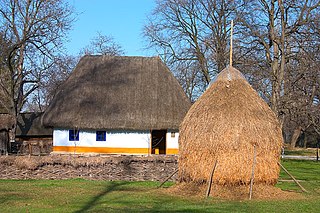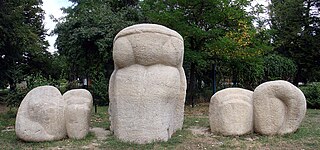 W
WA feature of Romanian culture is the special relationship between folklore and the learned culture, determined by two factors. First, the rural character of the Romanian communities resulted in an exceptionally vital and creative traditional culture. Folk creations were the main literary genre until the 18th century. They were both a source of inspiration for cultivated creators and a structural model. Second, for a long time learned culture was governed by official and social commands and developed around courts of princes and boyars, as well as in monasteries.
 W
WIn Romanian mythology, Baba Dochia, or The Old Dokia, is a figure identified with the return of spring. She is sometimes imagined as “an old woman who insults the month of March when she goes out with a herd of sheep or goats.” Supposedly the name originates from the Byzantine calendar, which celebrates the 2nd-century martyr-saint Eudokia of Heliopolis (Evdokia) on March 1. The Romanian Dokia personifies mankind's impatience in waiting for the return of spring.
 W
WBucur is the legendary Romanian shepherd who is said to have founded Bucharest, giving it his name. While the legend about the shepherd is probably apocryphal, the name of the city is actually quite likely derived from a person named Bucur, as the suffix -ești is used for settlements derived from personal names, usually of the owner of the land or of the founder, though it is more likely that Bucur was the noble who owned the land.
 W
WThe Călușari were the members of a Romanian fraternal secret society who practiced a ritual acrobatic dance known as the căluș. According to the Romanian historian Mircea Eliade, the Călușari were known for "their ability to create the impression of flying in the air" which he believed represented both the galloping of a horse and the dancing of the fairies (zîne). Indeed, the group's patron was the "Queen of the Fairies", who was also known as Irodiada and Arada, and who Eliade connected with the folkloric figure Diana.
 W
WDodola, also known under the names for butterfly: Paparuda, Peperuda, Perperuna or Preperuša, is a pagan tradition found in the Balkans. The central character of the ceremony is usually an orphan girl, less often, a boy. Wearing a skirt made of fresh green knitted vines and small branches, the girl born after the death of her father, the last girl child of the mother, sings and dances through the streets of the village, stopping at every house, where the hosts sprinkle water on her. The ritual is associated with a particular tune to which a particular dance is performed, not only by the girl, but also by the villagers who follow her through the streets, shouting their encouragement.
 W
WFăt-Frumos is a knight hero in Romanian folklore, usually present in fairy tales.
 W
WIleana Simziana or Ileana Sînziana is a Romanian fairy tale collected and written down by Petre Ispirescu between 1872 and 1886. It tells the story of an unnamed youngest daughter of an emperor, who dresses up as a man, goes to serve another emperor and rescues the titular princess Ileana. During a quest of obtaining the Holy Water she is hit by a curse of a monk that causes her to transform into a man - Făt-Frumos, who marries Ileana in the happy ending.
 W
WKukeri are elaborately costumed Bulgarian men, who perform traditional rituals intended to scare away evil spirits. Closely related traditions are found throughout the Balkans and Greece. The costumes cover most of the body and include decorated wooden masks of animals and large bells attached to the belt. Around New Year and before Lent, the kukeri walk and dance through villages to scare away evil spirits with their costumes and the sound of their bells. They are also believed to provide a good harvest, health, and happiness to the village during the year.
 W
WPăcală is a fictional character in Romanian folklore, literature and humor. An irreverent young man, seemingly a peasant, he reserves contempt and irony for the village authorities, but often plays the fool. Several derivative works codify the various versions of Păcală anecdotes. Examples include: Pâcală, by Ion Creangă; Păcală în satul lui by Ioan Slavici; Isprăvile lui Păcală by Petre Dulfu; and Întâmplările lui Păcală, part of Legende sau basmele românilor.
 W
WA sârba or sîrba is a Romanian dance normally played in 68 or 128 time. It can be danced in a circle, line, or couple formations and was historically popular not only in Romania, but also in Serbia, Ukraine, Hungary, Polish highlanders (Gorals) and Ashkenazi Jews. It is fast-paced and triplets are usually emphasized in the melody. The sîrba is still popular in Romanian traditional music and in Jewish Klezmer music. It was named after the Serbs.
 W
WSorcova is a Romanian popular custom, practiced on the morning of 1 January. This custom is very old and is spread throughout the country, being practiced mainly by children. Sorcova is also used to describe the object that characterizes this custom. It consists of a stick or twig decorated with artificial flowers of different colors, wherewith children slightly hit on back their parents or acquaintances in the morning of New Year, wishing them, in special verses, health and luck. When they begin to say the verses, sorcova is inclined in the direction of the person to whom they address all wishes, sorcova playing the role of a magic wand, endowed with the ability to transmit health, youth and fertility to the vised one; verses are very suggestive in this regard. The text of sorcova, reminiscent of a spell, merely reinforces the movement of sorcova.